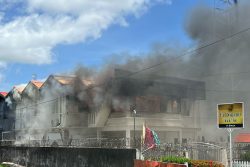Whenever the subject of parking in George-town is broached, one is loathe to enter into the discussion, since one suspects the initiator is trying to revive the ghost(s) of the 2016 parking meter fiasco and the subsequent US$100 million lawsuit (2021) against the Government of Guyana which it has been forced to fight whilst having to pay exorbitant legal fees billed in US dollars. This column seeks neither to address that issue, nor the seemingly unsolvable reckless driving phenomenon, but simply the migraine of parking in the inner core of the city – outlined by Seawall Road/Clive Lloyd Drive, Sheriff Street/ Mandela Avenue, East Bank Road/ Lombard Street/ Water Street.
Coexisting with the weekday inner city gridlock between the hours of 700 am and 600 pm, is the predicament of finding a parking spot. This ever burgeoning quandary revolves around two factors. First is the limited number of parking spots available at present within the aforementioned boundaries, and, second, the ever increasing motor vehicle population. At present, the Guyana Revenue Authority is registering close to two series of licence plates per annum, which introduces approximately another 20,000 vehicles to our road networks. Admittedly, not all of these vehicles are destined to operate within the city, but an unknown percentage do, and/or, will enter the city during the prime time hours, adding to the already swollen population. Clearly, this troublesome situation is not going to dry up and blow away.
Numerous examples of what this dilemma has blossomed into can be garnered with a frustrating one or two-hour cruise around the city during the peak hours. The city’s parking by-laws have long been abandoned and desperate drivers have resorted to: parking on either side of the road, pointing in any direction, often facing opposing traffic upon departure; perching their vehicles at the weirdest of angles on corners, thus, forcing drivers who wish cross the intersection to do so by “pushing out their nose” (in local parlance) at the risk of limb and peril, while hoping that no lunatic driver, nor kamikaze motorcyclist is bearing down on them; parking on, or, across the bridges of citizens, thus effectively barricading them in (or, out of) their own property; or, simply parking on the pavement, thus, forcing pedestrians to venture onto the roadway – an accepted norm on Alexander Street, the main thoroughfare in Kitty. It is also quite common to witness vehicles double parked – engine idling – on the street, whilst the driver purchases food or items from street vendors, or conducts a conversation with the occupant(s) of another double-parked car heading in the opposite direction, or simply fiddling with his/her iPhone, totally oblivious to the continuous honking of horns and the choicest of foul language emanating from the long line of delayed drivers.
Frustrated business owners have resorted to placing their own temporary ‘No Parking’ signs, and, or, cones in front of their premises, whilst equally fed up city residents ‘defend’ their territory by placing huge bricks or wooden logs across their entrances, and on the parapets in front of their properties. These barricades are often there without official sanction, which can vary according to whom one asks. One side of the political divide will claim that the Mayor and City Council (M&CC) holds the reins of power to issue such permits, whilst the other side will inform that it is the Ministry of Public Works which retains such jurisdiction.
A prime example of what this thorny issue has evolved into can be found in the northern block of Fort Street, Kingston, between Barrack Street and Battery Road, where on the western side, there is a plethora of official buildings: the Guyana Elections Commission, the Nurses and Midwives Council, a department of the Ministry of Health, the George-town School of Nursing, the Ministry of Public Works (several offices), the Public/Police Service Commissions, and the Ministry of Local Govern-ment and Regional Development. During business hours, motor vehicles are carefully aligned on both sides of the street at all times, much to the exasperation of the residents on the eastern half. Attempt-ing to squeeze through this phalanx is the equivalent of threading a needle, extreme caution is required, leading one to wonder how does a garbage truck ever get through that strait, or, to ponder how many rearview mirrors are knocked off on a daily basis.
This dilemma will only get progressively worse, as the motor vehicle population continues to expand exponentially, and the introduction of parking meters, and or a daily congestion charge, ought to be absolutely last resort solutions. (In London, England, there is a daily congestion charge for driving within certain areas of the city. The fee is £15 per day, and applies Monday through Friday from 7:00 am to 6:00 pm, and on weekends and bank holidays from 12:00 pm to 6:00 pm, but is not applicable between Christmas Day and New Year’s Day. New York also introduced congestion pricing from January 5 this year, with cars paying US$9 a day to operate below 60th Street.) These ‘taxes’ would just serve as a further burden on an already struggling population.
How does one crack this difficult nut? The widening of roadways, which the government is already tackling on main thoroughfares – including Carifesta Avenue and Thomas Road, at present – is one way, but it wouldn’t be financially practical to widen every main artery within such an expansive grid. A more pragmatic suggestion could be the establishment of parking lots at critical junctions within the city, or, on the periphery of the core. The latter could be developed by the private sector, such as banking and insurance institutions with large staff, who could then be shuttled to the city. Of course, incentives, such as relatively inexpensive leases, would have to be offered to induce such an arrangement.
The Mayor and City Council can develop its own lots, which could go a long way to easing the congestion, but with its current financial challenges, these would have to be joint-venture projects. Ambitious developments similar to the Banks DIH US$13 million six-storey parking facility on the East Bank Road, which was unveiled last July, and the proposed multi-storey parking lot to complement the new King’s Hotel and Residences at Waterloo and Quamina streets, are projects beyond the council’s immediate reach, but could form part of future plans. What the M&CC needs to avoid at all costs, is a repetition of the allegation levelled against the John Ford Car Park (named after the then Mayor of Georgetown) which was established when the East Street canal was filled in the early 1970s. In the eyes of a few engineers, this development was the link to increased flooding in the city during periods of excessive rainfall. (This hypothesis was never fully investigated.) The absorption of green spaces currently utilised for recreational pursuits, in efforts to resolve this riddle, also needs to be avoided.
The challenge of easing this parking crisis is a complex one. There is clearly no quick fix here, and a collaborative and an innovative approach is required to resolve it.









